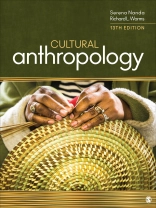Cultural Anthropology integrates critical thinking, explores rich ethnographies, and prompts students to think creatively about today’s culture and society. Authors Serena Nanda and Richard L. Warms show how historical studies and anthropological techniques can help readers reflect on the nature, structure, and meaning of human societies. Updates to the Thirteenth Edition include a new chapter on race and ethnicity; emphasis on areas such as inequality, power, gender, race, and history; discussions of issues around medical care and public health; and new features that reflect changes in world culture.
This title is accompanied by a complete teaching and learning package.
- Learning Platform / Courseware
SAGE Vantage is an intuitive learning platform that integrates quality SAGE textbook content with assignable multimedia activities and auto-graded assessments to drive student engagement and ensure accountability. Unparalleled in its ease of use and built for dynamic teaching and learning, Vantage offers customizable LMS integration and best-in-class support. It’s a learning platform you, and your students, will actually love.
- Assignable Video with Assessment
Assignable video (available in SAGE Vantage) is tied to learning objectives and curated exclusively for this text to bring concepts to life.
- Assignable Video with Assessment
- LMS Cartridge: Import this title’s instructor resources into your school’s learning management system (LMS) and save time. Don’t use an LMS? You can still access all of the same online resources for this title via the password-protected Instructor Resource Site.
Table of Content
Chapter 1: Anthropology And Human Diversity
The Fields of Anthropology
Some Critical Issues in Anthropology
Why Study Anthropology
The Global and the Local: The Anthropology of Violence
Chapter 2: Doing Cultural Anthropology
Anthropology in Historical Perspective
Anthropological Techniques
Some Critical Issues in Ethnography
Ethics in Fieldwork and Anthropology
The Global and the Local: The Anthropology of Pandemics and Other Disasters
Chapter 3: The Idea Of Culture
Defining Culture
Culture Is Made Up of Learned Behaviors
Culture Is the Way Humans Use Symbols to Classify Their World and Give It Meaning
Culture Is an Integrated System – or Is It?
Culture Is a Shared System of Norms and Values – Or Is It?
Culture Is the Way Human Beings Adapt to the World
Culture Is Constantly Changing
The Global and the Local: Is There an American Culture?
Chapter 4: Communication
Human and Animal Communication
Origins and Acquisition of Human Language
The Structure of Language
Language and Culture
Nonverbal Communication
Language Change
The Global and the Local: Language, Identity, and Assimilation
Chapter 5: Making a Living
Human Adaptation: The Environment and Technology
Foraging
Pastoralism
Horticulture
Agriculture
Industrialism
The Global and the Local: Climate Change and Food Choices
Chapter 6: Economics
Economic Behavior
Allocating Resources
Organizing Labor
Distribution: Systems of Exchange and Consumption
Capitalism
The Global and the Local: Paying for College in the United States
Chapter 7: Political Organization
Hierarchies: Power, Ideology, Gender, and Conflict
Band Societies
Tribal Societies
Chiefdoms
State Societies
The Nation-State
The Global and the Local: Citizenship and Statelessness
Chapter 8: Social Stratification: Class and Caste
Theories of Social Stratification
Criteria of Stratification: Power, Wealth, and Prestige
Social Class in the United States
Caste Systems
The Global and the Local: The Gig Economy
Chapter 9: Race and Ethnicity
Race and Biology
Race, Culture, and History
Race and Caste in the United States
Racial Classification in Brazil
Ethnicity
Immigration and Ethnicity in the United States
The Global and the Local: Inequality, Race, Ethnicity, and COVID-19
Chapter 10: Kinship
Kinship: Relations Through Descent and Marriage
Patrilineal Descent
Matrilineal Descent
Other Systems of Descent
Classifying Kin
The Global and the Local: Kinship and Immigration, and Transmigration
Chapter 11: Marriage, Family, And Domestic Groups
Marriage and Marriage Rules
Marriages With Multiple Partners
Exchanges of Goods at Marriage
Types of Families
The Global and the Local: Caring for the Elderly
Chapter 12: Gender
Sex, Gender, and Sexuality
Gender Ideologies: Female Sexuality and Male Prestige Behavior
Variability in Gender and Sexuality
Theories of Gender and Stratification
Gender Relations and Systems of Production
Changing Gender Relationships in an Interconnected World
The Global and the Local: Women’s Rights in Global Perspective—How Important Is Wealth?
Chapter 13: Religion
Religion in Society
Beliefs: Stories, Symbols, and the Supernatural
Practices: Addressing the Supernatural
Religious Practitioners
Religion and Change
Fundamentalism and Religious Change
The Global and the Local: The Globalization of Religion in the United States
Chapter 14: Creative Expression: Anthropology And The Arts
The Arts in Cultural Context
Art and the Expression of Cultural Themes
Art and Politics
Art and Expressing Identities
Art and Representing the Other
World Art: Culture, Marketing, and Tourism
The Global and the Local: Art and Censorship
Chapter 15: Making the Modern World: Conquest, Colonialism, and Resistance
European Expansion: Motives and Methods
The Eras of Colonialism
Making Colonialism Pay
Decolonization
The Global and The Local: Globalization, Nationalism, and Colonialism
Chapter 16: Anthropology in the 21st Century: Understanding and Acting in a Challenging World.
The Changing Political and Economic Environment
The Persistence of Poverty and Instability
Multinational Corporations
Urbanization
Population Pressure
The Rights of Indigenous People
Environmental Challenges
Looking to the Future
About the author
Richard L. Warms is professor of anthropology at Texas State University. His published works include Anthropological Theory: An Introductory History; Theory in Social and Cultural Anthropology: An Encyclopedia; and Sacred Realms: Essays in Religion, Belief, and Society. He also has written journal articles on commerce, religion, and ethnic identity in West Africa; African exploration and romanticism; and African veterans of French colonial armed forces. Warms’s interest in anthropology was kindled by college courses and by his experiences as a Peace Corps Volunteer in West Africa. He has traveled extensively in Africa, Europe, Asia, and South America. He continues to teach Introduction to Cultural Anthropology as well as classes in anthropological theory, the anthropology of religion, economic anthropology, and film at both the undergraduate and graduate level.












